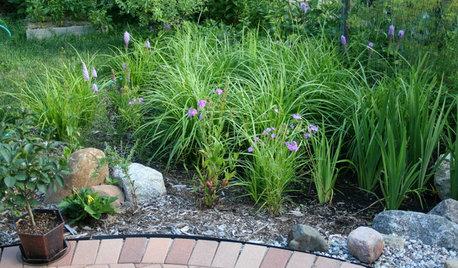fairly new to gardening but this site was a big help
lindsayg
16 years ago
Related Stories

GARDENING GUIDESGreat Garden Combo: 6 Beautiful Plants for a Shady, Wet Site
Transform a shade garden with moisture-loving golden grasses, textural leaves and a sprinkling of flowers
Full Story
GREEN BUILDINGOff the Grid: Siting and Building to Conserve Energy
Look to low-tech solutions for big energy savings when you’re constructing a home
Full Story
WINTER GARDENINGHow to Help Your Trees Weather a Storm
Seeing trees safely through winter storms means choosing the right species, siting them carefully and paying attention during the tempests
Full Story
LANDSCAPE DESIGNCelebrate a Sunny Climate With the Right Leafy Palm for Your Site
So you get freezes or floods. So your garden is small. These palms send excuses riding off into the tropical sunset
Full Story
PETS6 Ways to Help Your Dog and Landscape Play Nicely Together
Keep your prized plantings intact and your dog happy too, with this wisdom from an expert gardener and dog guardian
Full Story
EVENTSMaker Faire: The Future Is Now
Kid-friendly robots and high-tech sprinkling systems: This fair shows what’s new and next
Full Story
LANDSCAPE DESIGNHow to Site and Size a Rain Garden for Your Landscape
Installing a rain garden is an excellent way to reduce runoff and return water to its source
Full Story
LANDSCAPE DESIGNHow to Choose and Site Garden Art
The right piece in the right place can make or break the mood of your garden
Full Story
WORKING WITH PROSUnderstand Your Site Plan for a Better Landscape Design
The site plan is critical for the design of a landscape, but most homeowners find it puzzling. This overview can help
Full Story
SELLING YOUR HOUSEHelp for Selling Your Home Faster — and Maybe for More
Prep your home properly before you put it on the market. Learn what tasks are worth the money and the best pros for the jobs
Full Story






dchall_san_antonio
Kimmsr
Related Professionals
Surprise Landscape Contractors · Canyon Lake Landscape Contractors · Cockeysville Landscape Contractors · Hayward Landscape Contractors · Mastic Beach Landscape Contractors · Smyrna Landscape Contractors · Snoqualmie Landscape Contractors · Tehachapi Landscape Contractors · Vacaville Landscape Contractors · Waldorf Landscape Contractors · North Aurora Landscape Contractors · Adrian Decks, Patios & Outdoor Enclosures · Brentwood Decks, Patios & Outdoor Enclosures · Kearns Decks, Patios & Outdoor Enclosures · Overland Park Decks, Patios & Outdoor Enclosuresreversemidas
lindsaygOriginal Author
pnbrown
pnbrown
dchall_san_antonio
Kimmsr
pnbrown
dchall_san_antonio
Kimmsr
damanda